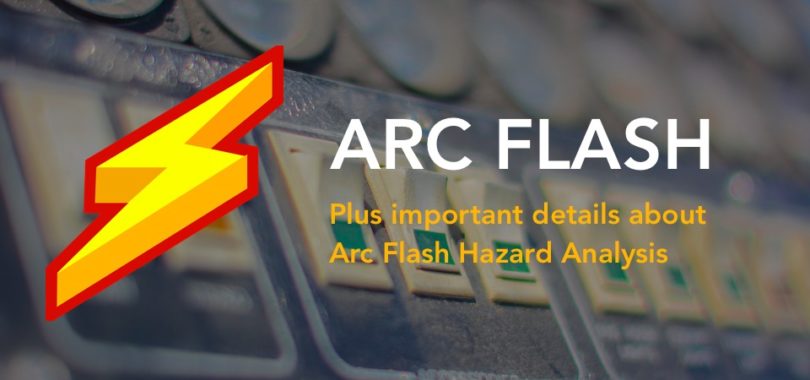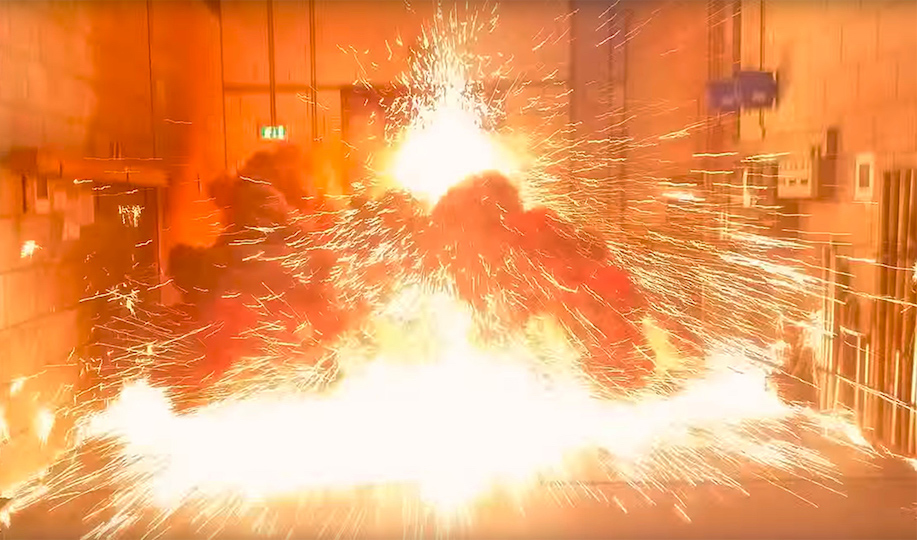The Basics Of Arc Flash; And Why You Really Don’t Want To Perform The Arc Flash Hazard Analysis Yourself
By Glenn Eglinton and Bob Dietzel, ARM, CIC
Hotter than the sun, with temperatures that soar as high as 35,000°F, the “arc flash” produces a blinding flash of light – followed by a dynamite-level explosion – that can vaporize metal and seriously injure anyone in its path. In this article, we’ll explain the arc flash and how to reduce risks associated with such a dangerous event.
When the filament breaks in an incandescent light bulb, a tiny, bright blue flash occurs inside the bulb. Most bulbs come with a built-in fuse – a small metal or wire conductor that melts and separates into two when there is too much current running through an electrical system. This small safety device – think of it as overcurrent protection – prevents an internal switch mechanism, the circuit breaker, from being “tripped” due to an unsafe surge of electricity.
The circuit breaker, usually found in the service panel, is designed to trip, or shut down, to protect the circuit from overheating and causing damage. It also protects against a much larger, more dangerous event from occurring – the “arc flash” (the light and heat) and the “arc blast” (a related explosion).
An arc flash – the bright light and intense heat created due to an electrical fault, or “arc fault” – is the result of a rapid release of energy, and while it can occur almost anywhere there is a fault in electrical current, it most often occurs at a circuit breaker connection.
“Arcing”, it turns out, is a quite common, and potentially hazardous event – and can occur when a electrician is working on an energized (live) circuit, repairing an electrical failure, changing out a fuse, checking voltage with the wrong meter, or adjusting a breaker in an electrical panel.
Want to discuss the Arc Flash Hazard Analysis with an expert? Contact an Arc Flash Consultant →
The risks, and potential for harm in the home, while changing out the standard 60 watt light bulb – which forces 0.5 amp of electrical current through the filament with 120 volts of pressure – are not insignificant. This is because it’s not the volts that kills a person, it’s the amps. And while it only takes a current between 0.1 to 0.2 map to be lethal, most modern residential circuits are 15 or 20 amps – rendering even the smallest house a potential hazard.
As power requirements increase – think industrial and residential circuit panels, large-scale electrical meters, industrial-strength plugs and connectors, and large tools and machinery – the potential for serious and fatal injuries grow as well.
In the workplace, there are any number of ways to achieve electrical arc flashing, and a common misconception is that arching needs a conductor – but this is not always the case. What is needed is a path for electricity to go forward or downward.
Want to talk with KMRD about risk control or to upgrade your company’s safety program? Contact KMRD →
An arc flash begins when electricity is diverted away from its expected path – due to a fault somewhere in the system – and instead begins to move through the air to find a grounded area. In a fraction of a second, the air becomes ionized and resistance along the new path is reduced, allowing electricity to “jump” away from the original wired path to the new one. As this sudden, high-temperature, low-impedance jump through the air occurs, a high-pressure sound wave – or “arc blast” explosion – is created.
The combination of the light and heat emitted by the arc flash and the pressure wave from the arc blast occurring simultaneously creates a monster powerful enough to cause serious wounds and burns – or worse.
(Note: We will not show images of arc flash/blast injuries here because of their graphic nature.)
The human body – as strong as it is – is not designed to withstand a powerful event of this speed or magnitude. In the blink of an eye – way too fast for anyone to “duck and cover” – there is an incredibly bright and hot flash of light (the arc flash), followed by a powerful explosion with the force of thousands of pounds of pressure per square inch – and a ball of fire that can cause severe burn injuries at distances of 10 feet. While an event like this emits enough heat to register over 35,000 degrees Fahrenheit, or almost four times hotter than the surface of the Sun, most clothing can ignite at temperatures from 400°C to 800°C (or 750°F to 1470°F).
While arc flashes – and arc blasts – can happen in most any situation where there is an electrical arc fault, in industries such as construction and mining, they are a leading cause of fatalities on the job. For this reason, electrical arc flash and arc blast injuries and deaths are near the top of insurers risk management concerns.
Past data from the U.S. Bureau of Labor Statistics (BLS) points to approximately 6000 fatal electrical injuries in the U.S. (all, not only arc flash and arc blast related) within an eleven year period (1992 to 2013) and over 24,000 non-fatal electrical injuries (2003 through 2012; the most recent 10-year data).
It has been estimated that arc flashes – and explosions – occur in electrical equipment 5 to 10 times per day in the U.S. In 2013 alone, there were 30,000 arc flash incidents, 7000 burn injuries, 2000 hospitalizations, and approximately 400 arc flash related deaths – approximately 80% of all fatalities due to burns, not shock – according to Industrial Safety & Hygiene News (ISHN), a magazine focused on workplace safety for environmental health and safety professionals.
This national issue has insurance providers scrambling to implement NFPA 70E procedures into their client’s electrical safety management programs. Successful programs combine the results of an Arc Flash Hazard Analysis – to determine the available energy in the client’s electrical system – and proper personal protective equipment (PPE) with employee training to mitigate preventable injuries and deaths and to comply with OSHA 1910.132.
The Arc Flash Hazard Analysis is part of a complete electrical hazard assessment required by OSHA and NFPA 70E. OSHA requires employers to protect employees from electrical hazards, including arc flash.
Want to discuss how your company can become NFPA 70E Arc Flash compliant? Request a Consult →
To mitigate or reduce the risk and keep your company in compliance – and to protect your workers from potential injury or death – seek professional assistance from a proven and reliable arc flash consultant able to provide the required Arc Flash Hazard Analysis, label all relevant equipment, assist in gear selection, and train employees to recognize and protect against arc flash and arc blast events.
Get an Experienced Engineer to Perform the Arc Flash Hazard Analysis
The Arc Flash Hazard Analysis and related assessment is a time-consuming and complex process, and requires experienced personnel familiar with conducting power analysis studies and arc flash analysis. Proper data has to be collected, and the people performing the analysis and assessment should understand how to conduct a short circuit study and protective device coordination study – and they need to know all the related regulations and codes.
In addition, performing this type of analysis and assessment incorrectly can be very expensive – with the potential for serious injury or worse. There is very little upside – and too much downside – for anyone without the right experience to do this “in-house”. Most organizations, except some larger ones with multiple/large facilities willing to cover the costs associated with carrying an internal team, should consider outsourcing the Arc Flash Hazard Analysis and assessment.
About Universal Electric Service, Inc.
Universal Electrical Service Inc., located in Souderton PA, is a turnkey solution for electrical arc awareness and risk mitigation. Our experienced team specializes in electrical safety services with an emphasis in Arc Flash Hazard Analysis and Arc Flash Assessments.
For a comprehensive system study estimate – or to discuss electrical compliance or arc flash safety regulations – please call UES at 1-800-331-5030 or visit them online at http://universalelectrical.com/

Glenn Eglinton is President at Universal Electrical Service, Inc. (UES) performs electrical construction, mechanical services, service and maintenance for industrial, energy and communications clients in the greater Greater Mid-Atlantic region.

Bob Dietzel is the Co-Founder and Principal at KMRD Partners Risk & Insurance Solutions, a leading risk management and human capital solutions firm the Philadelphia region.
Contact UsRequest Arc Flash Consult About Universal Electric
Note: This content is provided as general background information and should not be taken as legal advice or financial advice for your particular situation. Make sure to get individual advice on your case from a KMRD risk professional before taking any action.








